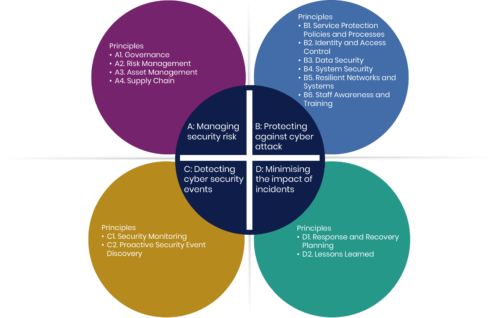Why the NCSC CAF?
For many, adopting a the ‘gold’ level Information Security standard ISO27001 is an impossible task due to resource and financial constraints. But there is hope! Frameworks such as the NCSC CAF offer excellent guidelines on the areas that must be considered when looking to add structure and assurance to your Cyber operations.
So grab a coffee and take a look at the CAF information below. We highly recommend clicking the link at the end and browsing around the NSCS website and the subcategories too… for us this simple website layout takes the fear out of ‘cyber governance’ and you can start to see instantly how this fairly light weight framework can support your organisation.
Understanding the NCSC Cyber Assessment Framework
The National Cyber Security Centre (NCSC) Cyber Assessment Framework (CAF) is a comprehensive tool designed to help organizations manage and mitigate cyber risks, particularly those that could have severe consequences. This article delves into the key aspects of the CAF, its objectives, and its significance in enhancing cybersecurity resilience.
1. Introduction to the Cyber Assessment Framework
The CAF was developed by the NCSC to provide a structured approach for assessing the cybersecurity posture of organizations responsible for critical network and information systems. These systems are essential for the functioning of society, including sectors like energy, healthcare, and transportation
The framework is particularly aimed at organizations that are part of the UK’s Critical National Infrastructure (CNI) or are subject to the Network and Information Systems (NIS) Regulations
2. Objectives of the CAF
The primary objectives of the CAF are to:
- Achieve and Demonstrate Cyber Resilience: Help organizations achieve a robust level of cyber resilience and demonstrate their ability to manage cyber risks effectively
- Protect Essential Functions: Ensure that essential functions, which if disrupted could cause significant harm to the economy, society, or individuals, are adequately protected
- Support Regulatory Compliance: Assist organizations in meeting regulatory requirements related to cybersecurity
3. Components of the CAF
The CAF is structured around four main objectives, each supported by a set of principles and indicators of good practice (IGPs):
- Managing Security Risk: This objective focuses on establishing governance structures, risk management processes, and security policies to manage cyber risks effectively
- Protecting Against Cyber Attack: This involves implementing measures to protect systems and data from cyber attacks, including access controls, network security, and secure configuration
- Detecting Cyber Security Events: Organizations must have the capability to detect cybersecurity events promptly through continuous monitoring, threat intelligence, and incident detection systems
- Minimizing the Impact of Incidents: This objective emphasizes the importance of having incident response plans, recovery procedures, and communication strategies to minimize the impact of cyber incidents
4. Application of the CAF
The CAF is designed to be flexible and scalable, allowing organizations of different sizes and sectors to tailor its application to their specific needs. It provides a systematic approach to assessing cybersecurity risks and implementing appropriate controls. Organizations can use the CAF to conduct self-assessments or seek external validation from cybersecurity oversight bodies
5. Benefits of the CAF
Implementing the CAF offers several benefits:
- Enhanced Cyber Resilience: By following the CAF, organizations can strengthen their cybersecurity posture and resilience against cyber threats
- Regulatory Compliance: The CAF helps organizations meet the requirements of the NIS Regulations and other relevant cybersecurity standards
- Improved Risk Management: The framework provides a structured approach to identifying, assessing, and managing cyber risks
- Increased Stakeholder Confidence: Demonstrating compliance with the CAF can enhance the confidence of stakeholders, including customers, partners, and regulators
6. Conclusion
The NCSC Cyber Assessment Framework is a vital tool for organizations seeking to enhance their cybersecurity resilience and protect essential functions from cyber threats. By providing a structured approach to managing cyber risks, the CAF helps organizations achieve and demonstrate a robust level of cyber resilience, ensuring the continued reliability and security of critical network and information systems.
For more detailed information and guidance on implementing the CAF, organizations can refer to the official NCSC website
: NCSC Cyber Assessment Framework : Introduction to the CAF Collection
Need a helping hand? Get in touch via our Contact Us form.


